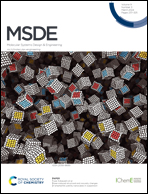Rational design of antimicrobial peptides: an optimization approach†
Abstract
With increasing concerns over antimicrobial resistance worldwide, antimicrobial peptides (AMPs) can be a potential alternative to conventional antibiotics. Generating new AMPs is challenging as there can be enormous combinations of amino acid residues leading to a vast number of possibilities. To alleviate this hurdle, a computer-aided AMP design framework is proposed in this study. Statistical analysis was performed to identify various physicochemical properties that characterize AMPs and their respective median values were used as design targets. A genetic algorithm (GA)-based optimization approach was formulated to design AMPs with maximum antimicrobial activity for any given peptide length. The peptide sequences generated in each generation of GA were first screened using a support vector machine-based antimicrobial activity classifier. A fitness function that measures the proximity of physicochemical property values to their respective design targets was then evaluated for all sequences classified as AMPs. Based on fitness scores, a new population of peptide sequences was generated by GA. The sequence with the maximum value of fitness function was finally reported as the optimal AMP. The performance of this framework was accessed using several case studies. Results obtained from this framework corroborated well with the findings reported in the literature. Thus, the proposed optimization-based design framework can be used to generate new AMP sequences. We have also developed an easy-to-use executable version of the proposed framework that can be accessed freely.

- This article is part of the themed collection: Emerging Investigator Series


 Please wait while we load your content...
Please wait while we load your content...